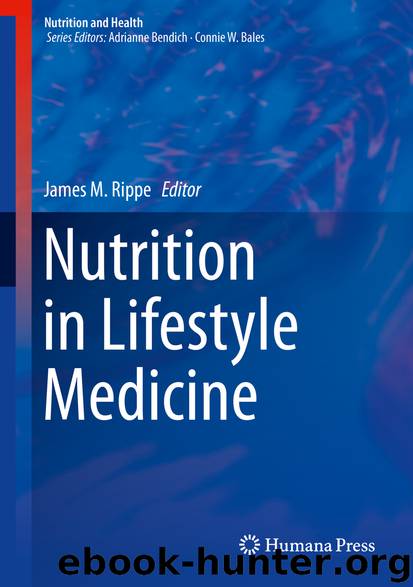Nutrition in Lifestyle Medicine by James M. Rippe

Author:James M. Rippe
Language: eng
Format: epub
Publisher: Springer International Publishing, Cham
Micronutrients and Oral Health
Calcium and Vitamin D
Calcium is an important mineral for skeletal health and it makes up over 99 % of bones and teeth. While the Recommended Dietary Allowance (RDA) for calcium is 1000–1200 mg/day, which varies with age and gender, most Americans are not meeting their needs. Vitamin D helps regulate calcium and enhances its absorption, and it also plays an important role in maintaining musculoskeletal and bone health. Vitamin D does not occur naturally in many foods. The main dietary sources of calcium for several people include foods fortified with vitamin D, such as dairy products, milk substitutes, and cereal. Sun exposure and supplements are also major sources [48]. Vitamin D’s anti-inflammatory properties along with its role in bone and mineral metabolism may have a positive effect on dental health. This is particularly important in periodontitis, where tooth loss may occur as a result of alveolar bone reabsorption. While the relationship between osteoporosis and vitamin D has been established, there may be evidence that osteoporosis is an early sign of periodontitis and vice versa [49].
Periodontal health was assessed by alveolar bone loss, pocket depth, and attachment loss in 562 men with an average age of 62.9 years. Participants in the Department of Veterans Affairs Dental Longitudinal Study between 1986 and 1998 were examined one to four times to study the effect of recommended intake of ≥800 IU of vitamin D on periodontal health. The dietary intakes of subjects were assessed using a Harvard University food frequency questionnaire to capture total vitamin D intake from food, and supplements. The study showed an inverse relationship between total vitamin D intake of ≥800 IU and risk of periodontal disease. Subjects who took vitamin D supplements were found to have less periodontal disease than those who did not use supplements, but the difference was not statistically significant [50].
The effect of various doses of vitamin D on gingivitis during a 3-month period was examined in 88 participants who were divided into one of four groups: 2000 IU for group A, 1000 IU for group B, 500 IU for group C, and group D received a placebo. Clinical examination during follow-up was conducted on days 30 and 60 to assess gingivitis severity as well as serum calcium to monitor vitamin D toxicity. Serum vitamin D level increased in each group in proportion to the dosage received. Gingivitis scores were significantly lower at follow up compared to baseline. The anti-inflammatory effects of all three groups receiving vitamin D were significantly higher compared to the placebo group. Improvements in gingivitis were seen earliest in group A, possibly due to serum vitamin D reaching the optimum levels of 32–35 ng/ml at a faster rate than the other groups. While vitamin D intakes at higher dosages revealed an earlier anti-inflammatory effect, there was not a significant difference between groups A and B or between B and C at the end of the study. It is hypothesized that anti-inflammatory levels may have stabilized after reaching serum vitamin D levels >32 ng/ml.
Download
This site does not store any files on its server. We only index and link to content provided by other sites. Please contact the content providers to delete copyright contents if any and email us, we'll remove relevant links or contents immediately.
Nutrition for Sport, Exercise, and Health by Spano Marie & Kruskall Laura & Thomas D. Travis(3715)
Nutrition for Sport, Exercise, and Health by Marie Spano & Laura Kruskall & D. Travis Thomas(3683)
The Sprouting Book by Ann Wigmore(3543)
Flavor Flours by Alice Medrich(2814)
Superfood Smoothie Bowls: Delicious, Satisfying, Protein-Packed Blends that Boost Energy and Burn Fat by Chace Daniella(2387)
Memory Rescue by Daniel G. Amen(2377)
Dirty Genes by Ben Lynch(2272)
The Bad Food Bible by Aaron Carroll(2235)
Genius Foods by Max Lugavere(2179)
The Poisoner's Handbook by Deborah Blum(2091)
Good Calories, Bad Calories by Gary Taubes(2072)
The Main Street Vegan Academy Cookbook by Victoria Moran(2033)
The I Quit Sugar Cookbook by Sarah Wilson(2001)
Core Performance Essentials by Mark Verstegen(1981)
Memory Rescue: Supercharge Your Brain, Reverse Memory Loss, and Remember What Matters Most by Amen Dr. Daniel G(1948)
Big Girls Do It Stronger by Jasinda Wilder(1899)
Android App Development by Franceschi Hervé J.;(1819)
Sugar Crush by Dr. Richard Jacoby(1770)
Dr. Colbert's Keto Zone Diet by Don Colbert(1629)
